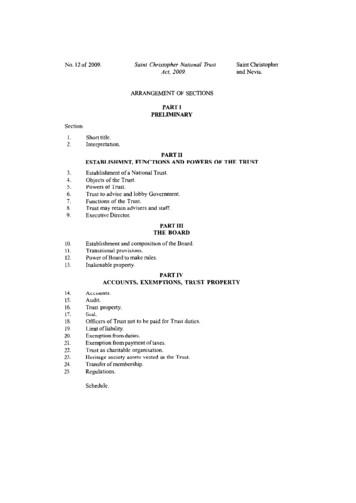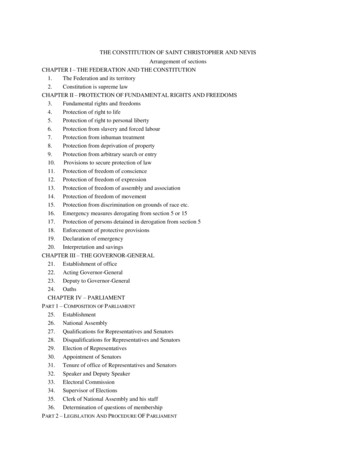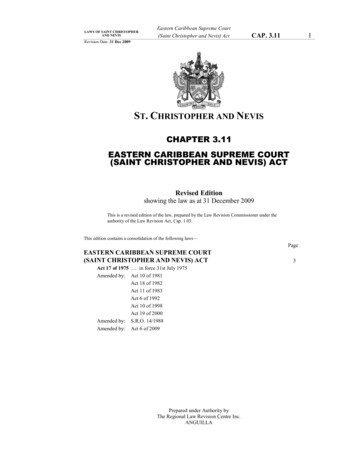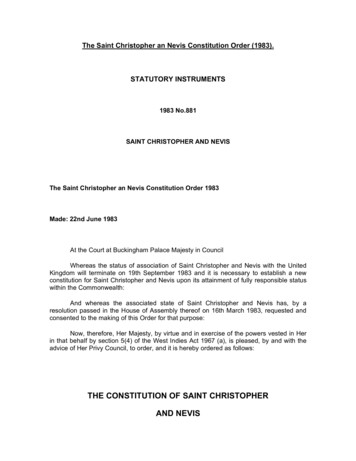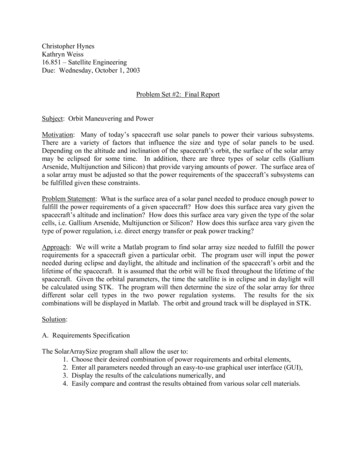
Transcription
Christopher HynesKathryn Weiss16.851 – Satellite EngineeringDue: Wednesday, October 1, 2003Problem Set #2: Final ReportSubject: Orbit Maneuvering and PowerMotivation: Many of today’s spacecraft use solar panels to power their various subsystems.There are a variety of factors that influence the size and type of solar panels to be used.Depending on the altitude and inclination of the spacecraft’s orbit, the surface of the solar arraymay be eclipsed for some time. In addition, there are three types of solar cells (GalliumArsenide, Multijunction and Silicon) that provide varying amounts of power. The surface area ofa solar array must be adjusted so that the power requirements of the spacecraft’s subsystems canbe fulfilled given these constraints.Problem Statement: What is the surface area of a solar panel needed to produce enough power tofulfill the power requirements of a given spacecraft? How does this surface area vary given thespacecraft’s altitude and inclination? How does this surface area vary given the type of the solarcells, i.e. Gallium Arsenide, Multijunction or Silicon? How does this surface area vary given thetype of power regulation, i.e. direct energy transfer or peak power tracking?Approach: We will write a Matlab program to find solar array size needed to fulfill the powerrequirements for a spacecraft given a particular orbit. The program user will input the powerneeded during eclipse and daylight, the altitude and inclination of the spacecraft’s orbit and thelifetime of the spacecraft. It is assumed that the orbit will be fixed throughout the lifetime of thespacecraft. Given the orbital parameters, the time the satellite is in eclipse and in daylight willbe calculated using STK. The program will then determine the size of the solar array for threedifferent solar cell types in the two power regulation systems. The results for the sixcombinations will be displayed in Matlab. The orbit and ground track will be displayed in STK.Solution:A. Requirements SpecificationThe SolarArraySize program shall allow the user to:1. Choose their desired combination of power requirements and orbital elements,2. Enter all parameters needed through an easy-to-use graphical user interface (GUI),3. Display the results of the calculations numerically, and4. Easily compare and contrast the results obtained from various solar cell materials.
1. Choose their desired combination of power requirements and orbital elements.To achieve this requirement, the user must input the following information:Pe Power needed during eclipsePd Power needed during daylightOrbit altitudeOrbit inclinationMission durationThe applicable formulas can be found in chapter 11.4 of SMAD. The eclipse and daylightperiods were calculated using STK. These calculations are also documented in the commentsof the code.2. Enter all parameters needed through an easy-to-use graphical user interface (GUI).The input and output values of the SolarArraySize program are illustrated in the blackboxbehavior diagram of Figure 1. More specifically, all calculations require power neededduring eclipse and daylight (measured in Watts), orbit altitude (measured in kilometers), orbitinclination (measured in degrees) and mission duration (measured in years). The followingoutputs were calculated for both direct energy transfer and peak power tracking: total powerneeded (measured in watts) and surface area (measured in meters squared) for GalliumArsenide, Multijunction and Silicon.The parameters are entered into Matlab through a GUI as shown in Figure 2. The outputfields are dynamically updated to reflect the entries input by the users.Figure 1. Blackbox Behavior Diagram
Figure 2. Graphical User Interface3. Display the results of the calculations numerically.The numerical output is also displayed through the GUI after the SolarArraySize programcalculates the total power needed and the sizes of the three solar cells for the two differentpower configurations. The orbit as well as the ground track is displayed in STK in a separatewindow. An example screen capture of the outputs to the user interface as well as theanimation in STK are shown in Figure 3.4. Easily compare and contrast the results obtained from various solar cell materials.The numerical outputs of the SolarArraySize can be compiled in tabular form (as done inTable 2) in order to perform trade-off analyses between the various materials.
B. Assumptionsa. Only circular orbits are handled by the SolarArraySize program.b. Inherent degredation of the three materials is 0.77, the nominal value as stated onpage 414 of SMAD.c. The Sun incidence angle, theta, is set at a 23.5 angle, the worst-case Sun angle asstated on page 417 of SMAD.C. Sample Test RunsOne example test run was executed using the data provided by SMAD for the FireSat satellite.Table 1 contains the information entered into the program through the GUI for test run.TestPower NeededEclipse (W)FireSat110Power NeededDaylight (W)OrbitAltitude (km)Orbit Inclination(deg)1107000Table 1. Inputs for Example Test RunMissionDuration(yrs)5The outputs can be compared with one another to determine which materials and/or powerregulation configuration best suits the needs of the project. Figure 3 is a screen capture of theGUI and STK interface during the execution of the test run.The results of the example test run are listed in Table 2. The results include the total powerneeded and the array sizes of the three types of material for both direct energy transfer and peakpower tracking. As seen in Table 2, the Multijunction material provides the total power neededwith the smallest amount of surface area. Next are the Gallium Arsenide and lastly the Silicon.The total power needed using direct energy transfer is nearly 15 Watts less than the peak powertracking configuration.Output Data224.023Total Power NeededDirect1.44214Gallium ilicon239.996Total Power NeededPeak1.54496Gallium liconTable 2. GUI Output from the Seven Test Runs
Figure 3. Screen Capture of SolarArraySize ProgramD. User’s Guidea. Setup: To run the SolarArraySize program, first open both Matlab and STK. Notethat STK Version 5 must be used to run the program. To initialize Matlab, the agiInitroutine should be run to setup the appropriate paths, and the default port (‘5001’)should be accepted along with default hostname ‘localhost’. Before runningSolarArraySize, you must type ‘stkinit’ at the Matlab prompt to set up the connectionbetween Matlab and STK software packages.Before running the program, make sure that the following three files are all in theMatlab working rraySize.asv.b. Running the Program: The SolarArraySize is run from the Matlab command promptby entering the command SolarArraySize. This opens the GUI window, and you willhave access to the solar array sizing program as shown in Figure 2.
c. Entering Parameters: Start by entering the requirements for your power system andyour desired orbit. The required initial data for all solar array sizing includes: powerneeded during daylight in Watts, power needed during eclipse in Watts, the orbitaltitude in kilometers, the orbit inclination angle in degrees and the mission durationin years. Enter the desired values for these parameters in the text boxes in place ofthe label “Edit Text”.d. Calculating Results: When all the necessary parameters have been entered, click theCalculate! button to calculate the total power needed and the solar array sizes of thethree materials for the two power configurations. The program will perform thenecessary calculations to output the orbit to STK for graphical display and thenumerical data to the GUI. A short waiting time is required.e. Displaying Results: The output parameters are displayed in the output window forthe two power configurations as follows: Total Power Needed, Gallium ArsenideSize, Multijunction Size and Silicon Size. For sample output from both STK and theSolar Array Sizing Environment (Matlab window), see Figure 3.E. Codefunction varargout SolarArraySize(varargin)% Begin initialization code - DO NOT EDITgui Singleton 1;gui State struct('gui Name',mfilename, .'gui Singleton', gui Singleton, .'gui OpeningFcn', @SolarArraySize OpeningFcn, .'gui OutputFcn', @SolarArraySize OutputFcn, .'gui LayoutFcn', [] , .'gui Callback', []);if nargin & isstr(varargin{1})gui State.gui Callback str2func(varargin{1});endif nargout[varargout{1:nargout}] gui mainfcn(gui State, varargin{:});elsegui mainfcn(gui State, varargin{:});end% End initialization code - DO NOT EDIT% Executes just before SolarArraySize is made visible.function SolarArraySize OpeningFcn(hObject, eventdata, handles, varargin)handles.output hObject;guidata(hObject, handles);clear global daylight power needed;
clear global eclipse power needed;clear global altitude;clear global inclination;clear global mission lifetime;global daylight power needed;global eclipse power needed;global altitude;global inclination;global mission lifetime;% Outputs from this function are returned to the command line.function varargout SolarArraySize OutputFcn(hObject, eventdata, handles)varargout{1} handles.output;% Executes on button press in calculate button.function calculate button Callback(hObject, eventdata, handles)global daylight power needed;global eclipse power needed;global altitude;global inclination;global mission lifetime;daylight power needed str2num(daylight power needed{1,1});eclipse power needed str2num(eclipse power needed{1,1});altitude str2num(altitude{1,1});inclination str2num(inclination{1,1});mission lifetime str2num(mission lifetime{1,1});[output data] calculatePSA(daylight power needed, eclipse power needed, altitude,inclination, mission lifetime);set(handles.total power needed direct energy transfer output, 'String', output data(1));set(handles.silicon direct energy transfer output, 'String', output data(2));set(handles.multijunction direct energy transfer output, 'String', output data(3));set(handles.gallium arsenide direct energy transfer output, 'String', output data(4));set(handles.total power needed peak power tracking output, 'String', output data(5));set(handles.silicon peak power tracking output, 'String', output data(6));set(handles.multijunction peak power tracking output, 'String', output data(7));set(handles.gallium arsenide peak power tracking output, 'String', output data(8));% Executes during object creation, after setting all properties.function daylight power needed inputbox CreateFcn(hObject, eventdata, handles)if ispcset(hObject,'BackgroundColor','white');else
rolBackgroundColor'));endfunction daylight power needed inputbox Callback(hObject, eventdata, handles)global daylight power needed;daylight power needed get(handles.daylight power needed inputbox, 'String');% Executes during object creation, after setting all properties.function mission duration inputbox CreateFcn(hObject, eventdata, handles)if BackgroundColor'));endfunction mission duration inputbox Callback(hObject, eventdata, handles)global mission lifetime;mission lifetime get(handles.mission duration inputbox, 'string');% Executes during object creation, after setting all properties.function eclipse power needed inputbox CreateFcn(hObject, eventdata, handles)if BackgroundColor'));endfunction eclipse power needed inputbox Callback(hObject, eventdata, handles)global eclipse power needed;eclipse power needed get(handles.eclipse power needed inputbox, 'String');% Executes during object creation, after setting all properties.function inclination inputbox CreateFcn(hObject, eventdata, handles)if BackgroundColor'));endfunction inclination inputbox Callback(hObject, eventdata, handles)global inclination;inclination get(handles.inclination inputbox, 'String');% Executes during object creation, after setting all properties.function altitude inputbox CreateFcn(hObject, eventdata, handles)if ispc
groundColor'));endfunction altitude inputbox Callback(hObject, eventdata, handles)global altitude;altitude get(handles.altitude inputbox, 'String');function [output data] calculatePSA(daylight power needed, eclipse power needed, altitude,inclination, mission lifetime)Xe direct energy transfer 0.65; % Efficiency during eclipse for direct energy transferXd direct energy transfer 0.85; % Efficiency during daylight for direct energy transferXe peak power tracking 0.6; % Efficiency during eclipse for peak power trackingXd peak power tracking 0.8; % Efficiency during daylight for peak power trackingId 0.77; % Nominal value for inherent degredationtheta 0.4101; % The solar array is at worstcase Sun angle between equatorial and eclipticplanesmaterial degradation GA .0275; % Gallium Arsenide degrades at 2.75% per year (worstcase)material degradation multijunction .005; % Multijunction Solar cells degrade at 0.5% peryear (worst case)material degradation Si .0375; % Silicon degrades at 2.75% per year (worst case)[periods] calculatePeriods(altitude, inclination);[periods] [periods] / 60; % Convert seconds to minutesoutput data(1) ((eclipse power needed * periods(1)) / Xe direct energy transfer (daylight power needed * periods(2)) / Xd direct energy transfer) / periods(2);output data(5) ((eclipse power needed * periods(1)) / Xe peak power tracking (daylight power needed * periods(2)) / Xd peak power tracking) / periods(2);power output Si 202.316; % 14.8% * 1,367 W/m 2 (incident solar radiation)power BOL Si powerBeginningLife(power output Si, Id, theta);power EOL Si powerEndLife(power BOL Si, material degradation Si, mission lifetime);power output multijunction 300.74; % 22% * 1,367 W/m 2 (incident solar radiation)power BOL multijunction powerBeginningLife(power output multijunction, Id, theta);power EOL multijunction powerEndLife(power BOL multijunction,material degradation multijunction, mission lifetime);power output GA 252.895; % 18.5% * 1,367 W/m 2 (incident solar radiation)power BOL GA powerBeginningLife(power output GA, Id, theta);power EOL GA powerEndLife(power BOL GA, material degradation GA,mission lifetime);
silicon area direct energy transfer output data(1) / power EOL Si;multijunction area direct energy transfer output data(1) / power EOL multijunction;gallium arsenide area direct energy transfer output data(1) / power EOL GA;silicon area peak power tracking output data(5) / power EOL Si;multijunction area peak power tracking output data(5) / power EOL multijunction;gallium arsenide area peak power tracking output data(5) / power EOL GA;output data(2) silicon area direct energy transfer;output data(3) multijunction area direct energy transfer;output data(4) gallium arsenide area direct energy transfer;output data(6) silicon area peak power tracking;output data(7) multijunction area peak power tracking;output data(8) gallium arsenide area peak power tracking;% determines the beginning of life power production% theta - Sun incidence angle between the vector normal to the surface in degrees% output - power at beginning of life (W/m 2)function power BOL powerBeginningLife(power output, inherent degradation, theta)power BOL power output * inherent degradation * cos(theta);% determines the end of life power production% output - power at end of life (W/m 2)function power EOL powerEndLife(power BOL, material degradation, lifetime) %lifetime inyearspower EOL power BOL * ( (1 - material degradation) lifetime );function [periods] calculatePeriods(altitude, inclination)stkinit;remMachine stkDefaultHost;% Open the Connect to STKconid stkOpen(remMachine);% first check to see if a scenario is open% if there is, close itscen open stkValidScen;if scen open 1stkUnload('/*')end% set up scenariocmd 'New / Scenario maneuver scenario';stkExec(conid, cmd);
% put the satellite in the scenariocmd 'New / */Satellite sat1';stkExec(conid, cmd);% set the scenario epochepochDate '"28 Sep 2003 00:00:00.00"';startDate epochDate;stopDate '"2 Oct 2003 00:00:00.00"';cmd ['SetEpoch * ' epochDate];stkExec(conid, cmd);stkSyncEpoch;% set the time period for the scenariostkSetTimePeriod(startDate, stopDate, 'GREGUTC');% set the animation parametersrtn stkConnect(conid,'Animate','Scenario/maneuver scenario','SetValues "28 Sep 200300:00:00.0" 60 0.1');rtn stkConnect(conid,'Animate','Scenario/maneuver scenario','Reset');% set up initial state% STK expects fields in meters NOT kilometerscmd ['SetState */Satellite/sat1 Classical J2Perturbation ' startDate ' ' stopDate ' 60 J2000 'epochDate ' ' num2str(altitude*1000 6378000) ' 0 ' num2str(inclination) ' 0 0 0'];stkExec(conid, cmd);% get eclipse duration from STK[secData, secNames] stkReport('*/Satellite/sat1', 'Eclipse Times')eclipse duration stkFindData(secData{1}, 'Total Duration');% set eclipse duration in secondseclipse duration unique(eclipse duration);x length(eclipse duration);eclipse duration eclipse duration(2 : (x-1));eclipse duration average mean(eclipse duration);% get sunlight duration from STK[secData, secNames] stkReport('*/Satellite/sat1', 'Sun')sunlight duration stkFindData(secData{1}, 'Duration');% set sunlight duration in secondsy length(sunlight duration);sunlight duration sunlight duration(2 : (x-1));sunlight duration average mean(sunlight duration);
% return eclipse and sunlight periods in secondsperiods(1) eclipse duration average;periods(2) sunlight duration average;% close out the stk connectionstkClose(conid)% this closes any default connectionstkClose
Approach: We will write a Matlab program to find solar array size needed to fulfill the power requirements for a spacecraft given a particular orbit. The program user will input the power needed during eclipse and daylight, the altitude and inclination of the spacecraft's orbit and the lifetime of the spacecraft.
